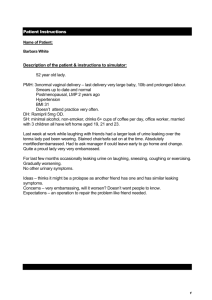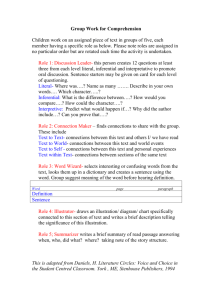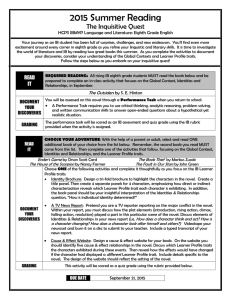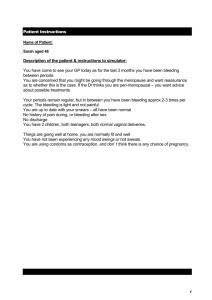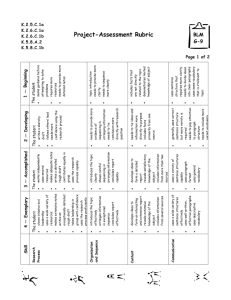Writing Development Continuum - Lower Dauphin School District
advertisement
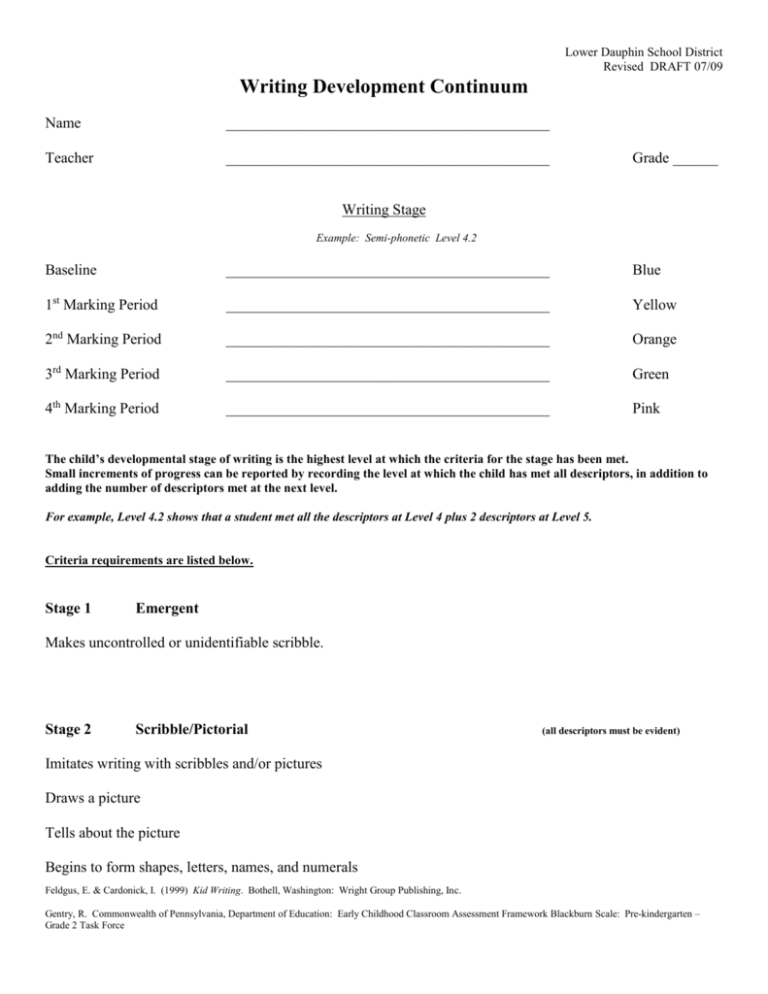
Lower Dauphin School District Revised DRAFT 07/09 Writing Development Continuum Name ___________________________________________ Teacher ___________________________________________ Grade ______ Writing Stage Example: Semi-phonetic Level 4.2 Baseline ___________________________________________ Blue 1st Marking Period ___________________________________________ Yellow 2nd Marking Period ___________________________________________ Orange 3rd Marking Period ___________________________________________ Green 4th Marking Period ___________________________________________ Pink The child’s developmental stage of writing is the highest level at which the criteria for the stage has been met. Small increments of progress can be reported by recording the level at which the child has met all descriptors, in addition to adding the number of descriptors met at the next level. For example, Level 4.2 shows that a student met all the descriptors at Level 4 plus 2 descriptors at Level 5. Criteria requirements are listed below. Stage 1 Emergent Makes uncontrolled or unidentifiable scribble. Stage 2 Scribble/Pictorial (all descriptors must be evident) Imitates writing with scribbles and/or pictures Draws a picture Tells about the picture Begins to form shapes, letters, names, and numerals Feldgus, E. & Cardonick, I. (1999) Kid Writing. Bothell, Washington: Wright Group Publishing, Inc. Gentry, R. Commonwealth of Pennsylvania, Department of Education: Early Childhood Classroom Assessment Framework Blackburn Scale: Pre-kindergarten – Grade 2 Task Force Lower Dauphin School District Revised DRAFT 07/09 Stage 3 Precommunicative (all descriptors must be evident) Is interested in having ideas written down (is able to dictate a complete and meaningful thought) Strings together random letters, numerals, and letter-like forms Writes letters to convey a message Attempts to read writing back Prints own name Prints an occasional word Understands concept of word Stage 4 Semi-Phonetic (all descriptors must be evident) Begins to understand there is a relationship between letters and sounds Selects some letters to match sounds Usually uses one correct beginning letter to write a word Separates most words with spaces Usually writes left to right (may reverse some letters) Usually writes top to bottom Spells some kindergarten high frequency words correctly; uses word wall appropriately Writes the substance of one sentence (one meaningful thought); may not be accurately punctuated Reads own writing Feldgus, E. & Cardonick, I. (1999) Kid Writing. Bothell, Washington: Wright Group Publishing, Inc. Gentry, R. Commonwealth of Pennsylvania, Department of Education: Early Childhood Classroom Assessment Framework Blackburn Scale: Pre-kindergarten – Grade 2 Task Force Lower Dauphin School District Revised DRAFT 07/09 Stage 5 Phonetic (all descriptors must be evident) Uses logical phonetic spelling with two or more letters in a word Usually represents words with correct beginning and ending consonant sounds Includes vowels (may not be correct); shows an awareness of medial vowels in words Writes left to right, top to bottom in a linear format Points to words while reading Separates words with spaces Spells kindergarten high frequency words accurately; spells some first grade high frequency words accurately Uses both upper and lower case letters appropriately within words Writes the substance of multiple sentences (at least 2-3) on a related topic; may not be accurately punctuated ** To bridge to the transitional level, the child should move away from patterned writing to using varied sentence structures. Stage 6 Transitional (all descriptors must be evident) Uses logical phonetic spelling, including vowels Writes multi-syllabic words, including vowels in most syllables Correctly spells all kindergarten and first grade high frequency words Uses a variety of class resources to locate spellings of unfamiliar words Capitalizes all proper nouns and the pronoun “I” Uses all capital and lower case letters correctly Simple sentences are usually punctuated correctly (period, question mark, exclamation point) Experiments with punctuation and its use (comma, apostrophe) Writes the substance of multiple sentences (at least 3-4) on a related topic Uses subject verb agreement Uses a variety of sentence structures and lengths Feldgus, E. & Cardonick, I. (1999) Kid Writing. Bothell, Washington: Wright Group Publishing, Inc. Gentry, R. Commonwealth of Pennsylvania, Department of Education: Early Childhood Classroom Assessment Framework Blackburn Scale: Pre-kindergarten – Grade 2 Task Force Lower Dauphin School District Revised DRAFT 07/09 Writes using different genres of writing (stories, lists, notes, etc.) ** To bridge to the next level, the child should use varied complex sentence structures, even though they may not be accurately punctuated (rather than a series of accurately punctuated simple sentences) Stage 7 Conventional 1 (all descriptors must be evident) Uses larger, correctly spelled vocabulary words; may use phonetic spelling for advanced words/multi-syllabic words Correctly spells most second grade high frequency words Punctuates all simple sentences correctly (period, question mark, exclamation point) Uses a variety of descriptive words Uses varied and complex sentence structures (including conjunctions, prepositional phrases) Uses subject verb agreement in all sentence lengths Begins to revise and edit independently Uses a larger vocabulary Writes the substance of multiple sentences (at least 4-5) on a related topic Stage 8 Conventional 2 (all descriptors must be evident) Correctly spells most words with regular spelling patterns; may use phonetic spelling for unfamiliar or advanced words Uses a variety of sentence structure and length; incorporates transitional words and phrases Organizes writing into appropriate paragraphs Spells all second grade high frequency words correctly Uses a rich and descriptive vocabulary Usually uses advanced print conventions appropriately (quotation marks, commas, apostrophes, contractions, possessives) Uses verb endings (s, es, ed, d, ing) Writes the substance of multiple sentences (at least 5-6) on a related topic Feldgus, E. & Cardonick, I. (1999) Kid Writing. Bothell, Washington: Wright Group Publishing, Inc. Gentry, R. Commonwealth of Pennsylvania, Department of Education: Early Childhood Classroom Assessment Framework Blackburn Scale: Pre-kindergarten – Grade 2 Task Force Lower Dauphin School District Revised DRAFT 07/09 Stage 9 Advanced (all descriptors must be evident) Uses conventional spelling and rules to include inflected endings, plurals, and verb tenses Possesses a large body of written vocabulary; uses a variety of words consistently in writing Uses advanced print conventions appropriately (quotation marks, commas, apostrophes, contractions, possessives) Edits written work for spelling and punctuation Edits written work by adding new ideas and information Uses writing as a tool for learning (summaries, reports, outlines, research) Writes both fiction and nonfiction writing Responds to a writing prompt Writes topic sentence with relevant information to develop cohesive text Organizes paragraphs logically to form cohesive text Independently uses a plan to organize ideas; may use graphic organizers Feldgus, E. & Cardonick, I. (1999) Kid Writing. Bothell, Washington: Wright Group Publishing, Inc. Gentry, R. Commonwealth of Pennsylvania, Department of Education: Early Childhood Classroom Assessment Framework Blackburn Scale: Pre-kindergarten – Grade 2 Task Force
